|
|
|
Description |
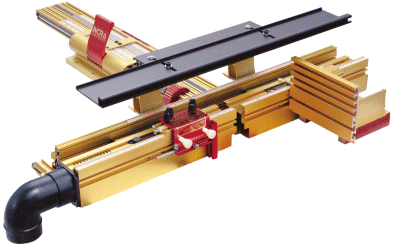 |
| The system is offered in two sizes, 17" and
25" and with the basic fence or the Wonder Fence setups. The system comes with a
right angle fixture, assembly and operation manuals as well. The operation manual includes
an extensive set of templates. The templates are slid into channels that can be seen
on the top of the jig body. In addition to the plastic templates, a metal scale is
held in place magnetically (for ease of adjustment). The manual is a large format
and does a pretty good job of explaining how to use the system for the more common joints.
About half of the manual consists of joint layout guides. Incra-Mental |
|
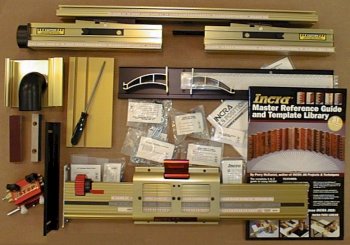 |
Assembly The system comes well packed in a single box. The parts for the various assemblies are subdivided into little plastic bags that are clearly identified by the instructions. It may not look like it but there isn't much assembly to the main jig itself. Most of the assembly is in the right angle fixture and the Wonder Fence to the rest of the jig. The parts do include a set of shims should they be needed to make the fence faces true 90 degrees to the table, I didn't use mine. It will probably take longer to read the instructions than it will to assemble the jig. |
| Jig Joint As mentioned, the Incra system is capable of producing a variety of woodworking joints. Although it can do more, the standard joints include half-blind dovetails, through dovetails, and box joints. Due to the repeatable precision the jig offers, it also allows variations of these joints such as double dovetails. The templates provided give the cutting sequence for a desired joint type and spacing. In reality the templates are nothing more than tape measures with the unused marking removed. I'll briefly mention the three common joints as an example of how the system works. Half-blind Dovetails The Incra operates differently than common "cookie cutter" jigs for this type of joint. Although the Incra is and Edge reference machine, half-blind joints are effectively cut on a center reference so the first step is to set the jig relative to the center of the stock. This is where the micro adjustment will first come in handy to move the fence to the exact center. Like all HB jigs, the cutter height controls the joint fit. Unlike some jigs, the pin and tails pieces are cut separately. The pins are cut face up and the tails are cut on end. The pins joint leaves a common half-rounded profile cut but the tails cut is not rounded. To accommodate this, a relief cut is made on the tails before hand; this allows a square peg to fit into a round hole so to speak. Because it is a numerical machine, the Incra will easily accommodate lipped drawer fronts and such. Through Dovetails The Incra cuts through joints differently than most jigs. Here the cutter height will affect the joint fit. To make the joint, using the template one makes on-end cuts in both joints. The pins are then refined with the face down cut. Some minor work with a sharp chisel or knife is required to actually complete the joint profile, it is very minor work though. Through joints are easier to cut than this description may imply. Both the HD and through joints can be made with a wide variety of dovetail bit sizes and angles. This is an often overlooked feature of the Incra system. Box Joints Box Joints are quite easy, it simply involves moving the fence in increments of twice the bit diameter. Unlike the common box joint jig that uses a pin, the Incra is a great deal more accurate and repeatable. Also, the Incra is not subject to the same tolerance stack-up issues that plague the pin type jig. They key though is to have an accurately sized router bit to begin with. Other Uses Even if the system were not used for any of the joinery mentioned previously, it would have merit and usefulness just in its abilities as in incremental positioner. There are many times one would want to move the fence by several fixed increment units or a hundredth of an inch or less to make a joint fit properly. The system allows this to be done quite easily and all under your control. This is quite an improvement over analog "bump and hope" methods of fence movement. While some may claim that the accuracy of the system is overkill, the real issue is that it provides accurate repeatability, the inherent accuracy is just the means used to achieve it. |
| Chassis The clamping section or chassis of the jig has been changed to accommodate the new lead screw system. It is more stream lined (and pretty I think) compared to the previous model. The clamp arm is fairly big and easy to operate. The clamp can be in one of three positions, unclamped, clamped, and half-clamped. When unclamped the jig can be slid entirely free of the chassis. At first I didn't see any reason for allowing this but I actually use this aspect to my advantage. On my setup (extension wing of a tablesaw), this allows me to easily remove the system but keep the chassis bolted in place. When I use my tablesaw rip fence I sometimes need the few extra inches that the Incra fence occupies. Pulling the jig out of the chassis allows me to recover that space without uninstalling the whole system. |
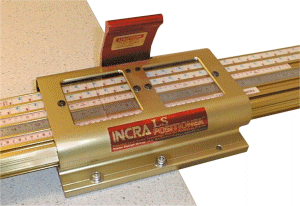 |
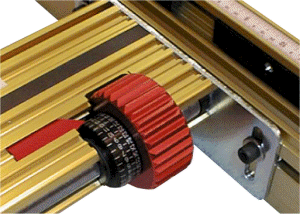 |
Micro Adjustment In addition to the normal 1/32" pitch movements, the jig can be micro adjusted as well. Near the fence there is a large red ring attached to the lead screw. The ring is detented and when the clamp lever is in the half-locked position, the ring can be rotated to move the fence in very small increments. Each "click" of the detent is equal to 0.001". This feature is most often used to zero out the fence to the bit. The detent pressure can also be set so that the detents are not used should one desire a "true - analog" micro adjuster. |
| The Fence The basic fence is, well, basic. It's a thin cross-section with the Incra racks (used by the stop) on one side and a relatively small cut out for the bit in the middle, there is no provision for dust collection. A ¼-20 channel in the face and the will allow sacrificial faces to be installed if desired. This is the same fence included in the standard LS SuperSystem package. If the system were only used for the basic corner joints, this fence is all that is needed. The Wonder Fences attaches to the (milled) face of the basic fence. This fence system is comprised of a left and right half as well as a riser to help with taller stock. The fence halves can be attached to create a very wide bit opening if desired. The fences halves can be offset from one another about 0.25" as well. This could be used for router-jointer operations and with some moulding cutters that remove the reference edge. |
| Right Angle Fixture The fixture is basically a broad thin aluminum extrusion that is held vertical to the fence by a sled that grabs the top of the router fence. A series of t-slots in the face of the extrusion allow ¼-20 type clamp fixtures to be used if desired. The sled rides on replaceable plywood runners (just in case you hit the cutter, damhikt). The fixture can be used on either the standard or Wonder Fence without any adjustments. |
| Installation Shown here is the unit installed onto the right extension of my tablesaw. There is more than one way to mount the chassis, I'm using four 1/4-20 Allen bolts to screw it to the table itself. The Incra jig like this one is probably used more often on a stand-alone router table. For that application it would be hard to imagine needing more than the 17" version. It is important to note that the system requires extra open space to the right of the table to operate at full capacity. You can see that with the system pulled out of the chassis I still have almost the full capacity range on the saw rip fence. |
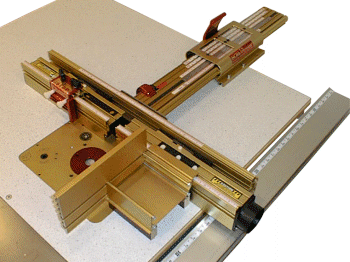 |
| Summary Again, if you are new to woodworking, the Incra system reviewed here is primarily designed as a router table jig. Incra also makes a similar system that can be used as a tablesaw rip fence that can also accept the Wonder Fence for router operations. The positioner can and has been used for a multitude of applications besides these though. If you have never used one of these incremental jigs before, you are in for a treat. It will only take about five minutes of operation to conclude they are the best thing since the invention of the circular saw blade. The Incra LS SuperSystem represents one of the major milestones in modern woodworking accessories. Incra could justifiably alter the ad line from Dupont and say "we don't cut the wood, we allow it to be cut accurately". This article is actually only a brief glimpse into the capability of the jig.
In the interest of full disclosure, Incra provided this product to facilitate this review.
|